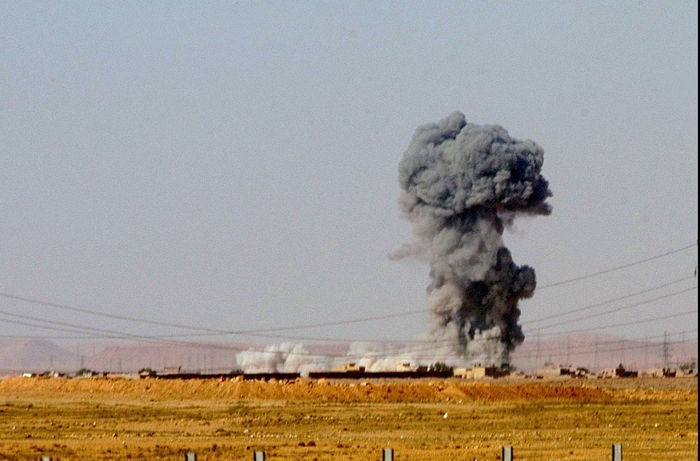Syria, a playground for flexing muscles
Russia and the US are both fighting ISIL, yet support opposite sides of the Syrian Civil War. The village of Rotba is hit by a U.S. missile, as seen from the road between Baghdad and the Syrian border, Tuesday April 1, 2003.
October 20, 2015
The U.S. and its allies have scheduled a missile defense test to be held sometime in October, somewhere in Europe.
None of the parties has specified the exact time and location of this event, but the significance of this happening lies in its timing.
Earlier this month, Russia began a series of bombings in Syria, allegedly targeting the Islamic State of Iraq and the Levant (ISIL) targets, which has led to some hostile accusations from both the U.S. and Russia.
Coincidentally, the tests are scheduled to be held almost immediately after Russia’s intense involvement in the Syrian Civil War.
The U.S. and allies have brought forth numerous analyses and geographical reports stating that the Russian airstrikes are targeting those opposing Syrian President Bashar al-Assad’s regime, and Russian President Vladimir Putin has not denied these accusations.
But on Oct. 18, the Britian-based Syrian Observatory for Human Rights stated that, “At least 40 fighters belonging to the Islamic State of Iraq and the Levant (ISIL) have been killed in an air strike on their convoy in the Syrian province of Hama.”
The Observatory did not identify whether the air strikes were committed by Russian forces or Syrian, but they maintained that the strikes did not come from the Washington led coalition.
It is interesting to note that although Russia and the U.S. have both declared that they are fighting ISIL, they support opposite sides of the Syrian Civil War.
Since the beginning of the conflict, the U.S. has focused on getting rid of Assad, seeing as he threatened to gas his own people. Although Russia has intervened since the start of the civil war, only recently did Putin command military action in support of Assad and his regime.
Earlier in September, Putin told the United Nations General Assembly at U.N. headquarters that “There is no other solution to the Syrian crisis than strengthening the effective government structures and rendering them help in fighting terrorism.”
President Putin once again confirmed that the best and surest way of solving the crisis in Syria, as well as stopping ISIL, was to support Assad’s regime, according to a recent interview conducted by the Russian federal TV.
President Putin may not be far from finding a solution.
After all, the $500 million Pentagon program which relied on training locals to counter ISIL has immensely failed, seeing as “few recruits would agree to its goal of fighting only the militant Islamic State and not Mr. Assad,” reported Al Jazeera.
A direct result of these superpowers’ show of force is that now Syria has become almost a playground for weapons demonstration.
Locals report that the insurgents are fighting with U.S. weapons, and Assad’s regime is relying on Russian manufactured weapons and artillery.
Nonetheless, civilians continue to be involved in what has now stretched to more than simply a Middle-Eastern conflict. It has now become Europe’s priority to end the crisis, thanks to the multitude of migrants continuing to seek refuge in Western Europe.
The missile defense test is claimed to be nothing more than a regular operations review, where “The goal of the exercises is to test the allies’ capability to counter multiple missile threats and coordinate their actions in defending against several missiles at once, which is known as an integrated air and missile defense concept,” according to
military.com, an online resource center dedicated to providing services to U.S. military personnel.
Nevertheless, the timing of this test seems close to Russia’s recent involvement in Syria’s war, and the scheduling of the test resembles a show of power from the U.S. and allies.
In essence, this timely drill is meant to strengthen the bond between the U.S. and allies, as well as make sure that the countries in this coalition are on the same page, meaning the U.S. will spearhead any actions, and that the allies will support any such action.
At the same time, it is possible that these drills are also designed to be a show of power – a sort of flexing of the muscles from the side of the NATO – intended to reflect their unfaltering countenance even after Putin’s air strikes in Syria.
In any case, it is imperative that the two powers are able to sort their differences out before more innocent people are caught in the crossfire between prominent Western powers and Putin’s disagreements.
Bogdan (Theo) Mynka is a freshman studying music from Kharkiv, Ukraine. He can be contacted at 335-2290 or by [email protected]. The opinions expressed in this column are not necessarily those of the staff of The Daily Evergreen or those of the Office of Student Media.



















